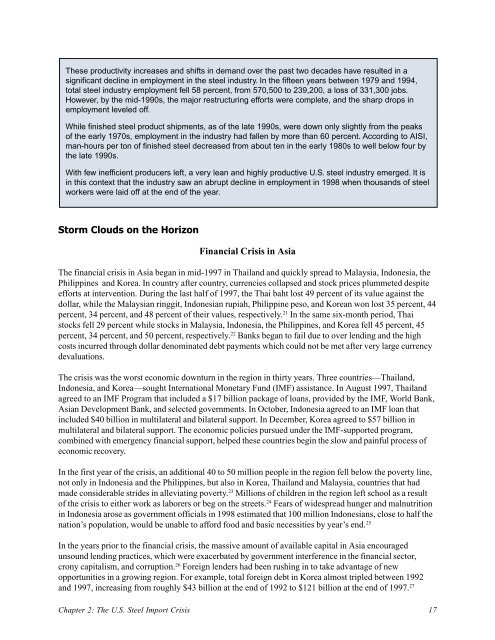Global Steel Trade; Structural Problems and Future Solutions
Global Steel Trade; Structural Problems and Future Solutions
Global Steel Trade; Structural Problems and Future Solutions
Create successful ePaper yourself
Turn your PDF publications into a flip-book with our unique Google optimized e-Paper software.
These productivity increases <strong>and</strong> shifts in dem<strong>and</strong> over the past two decades have resulted in a<br />
significant decline in employment in the steel industry. In the fifteen years between 1979 <strong>and</strong> 1994,<br />
total steel industry employment fell 58 percent, from 570,500 to 239,200, a loss of 331,300 jobs.<br />
However, by the mid-1990s, the major restructuring efforts were complete, <strong>and</strong> the sharp drops in<br />
employment leveled off.<br />
While finished steel product shipments, as of the late 1990s, were down only slightly from the peaks<br />
of the early 1970s, employment in the industry had fallen by more than 60 percent. According to AISI,<br />
man-hours per ton of finished steel decreased from about ten in the early 1980s to well below four by<br />
the late 1990s.<br />
With few inefficient producers left, a very lean <strong>and</strong> highly productive U.S. steel industry emerged. It is<br />
in this context that the industry saw an abrupt decline in employment in 1998 when thous<strong>and</strong>s of steel<br />
workers were laid off at the end of the year.<br />
Storm Clouds on the Horizon<br />
Financial Crisis in Asia<br />
The financial crisis in Asia began in mid-1997 in Thail<strong>and</strong> <strong>and</strong> quickly spread to Malaysia, Indonesia, the<br />
Philippines <strong>and</strong> Korea. In country after country, currencies collapsed <strong>and</strong> stock prices plummeted despite<br />
efforts at intervention. During the last half of 1997, the Thai baht lost 49 percent of its value against the<br />
dollar, while the Malaysian ringgit, Indonesian rupiah, Philippine peso, <strong>and</strong> Korean won lost 35 percent, 44<br />
percent, 34 percent, <strong>and</strong> 48 percent of their values, respectively. 21 In the same six-month period, Thai<br />
stocks fell 29 percent while stocks in Malaysia, Indonesia, the Philippines, <strong>and</strong> Korea fell 45 percent, 45<br />
percent, 34 percent, <strong>and</strong> 50 percent, respectively. 22 Banks began to fail due to over lending <strong>and</strong> the high<br />
costs incurred through dollar denominated debt payments which could not be met after very large currency<br />
devaluations.<br />
The crisis was the worst economic downturn in the region in thirty years. Three countries—Thail<strong>and</strong>,<br />
Indonesia, <strong>and</strong> Korea—sought International Monetary Fund (IMF) assistance. In August 1997, Thail<strong>and</strong><br />
agreed to an IMF Program that included a $17 billion package of loans, provided by the IMF, World Bank,<br />
Asian Development Bank, <strong>and</strong> selected governments. In October, Indonesia agreed to an IMF loan that<br />
included $40 billion in multilateral <strong>and</strong> bilateral support. In December, Korea agreed to $57 billion in<br />
multilateral <strong>and</strong> bilateral support. The economic policies pursued under the IMF-supported program,<br />
combined with emergency financial support, helped these countries begin the slow <strong>and</strong> painful process of<br />
economic recovery.<br />
In the first year of the crisis, an additional 40 to 50 million people in the region fell below the poverty line,<br />
not only in Indonesia <strong>and</strong> the Philippines, but also in Korea, Thail<strong>and</strong> <strong>and</strong> Malaysia, countries that had<br />
made considerable strides in alleviating poverty. 23 Millions of children in the region left school as a result<br />
of the crisis to either work as laborers or beg on the streets. 24 Fears of widespread hunger <strong>and</strong> malnutrition<br />
in Indonesia arose as government officials in 1998 estimated that 100 million Indonesians, close to half the<br />
nation’s population, would be unable to afford food <strong>and</strong> basic necessities by year’s end. 25<br />
In the years prior to the financial crisis, the massive amount of available capital in Asia encouraged<br />
unsound lending practices, which were exacerbated by government interference in the financial sector,<br />
crony capitalism, <strong>and</strong> corruption. 26 Foreign lenders had been rushing in to take advantage of new<br />
opportunities in a growing region. For example, total foreign debt in Korea almost tripled between 1992<br />
<strong>and</strong> 1997, increasing from roughly $43 billion at the end of 1992 to $121 billion at the end of 1997. 27<br />
Chapter 2: The U.S. <strong>Steel</strong> Import Crisis 17
















